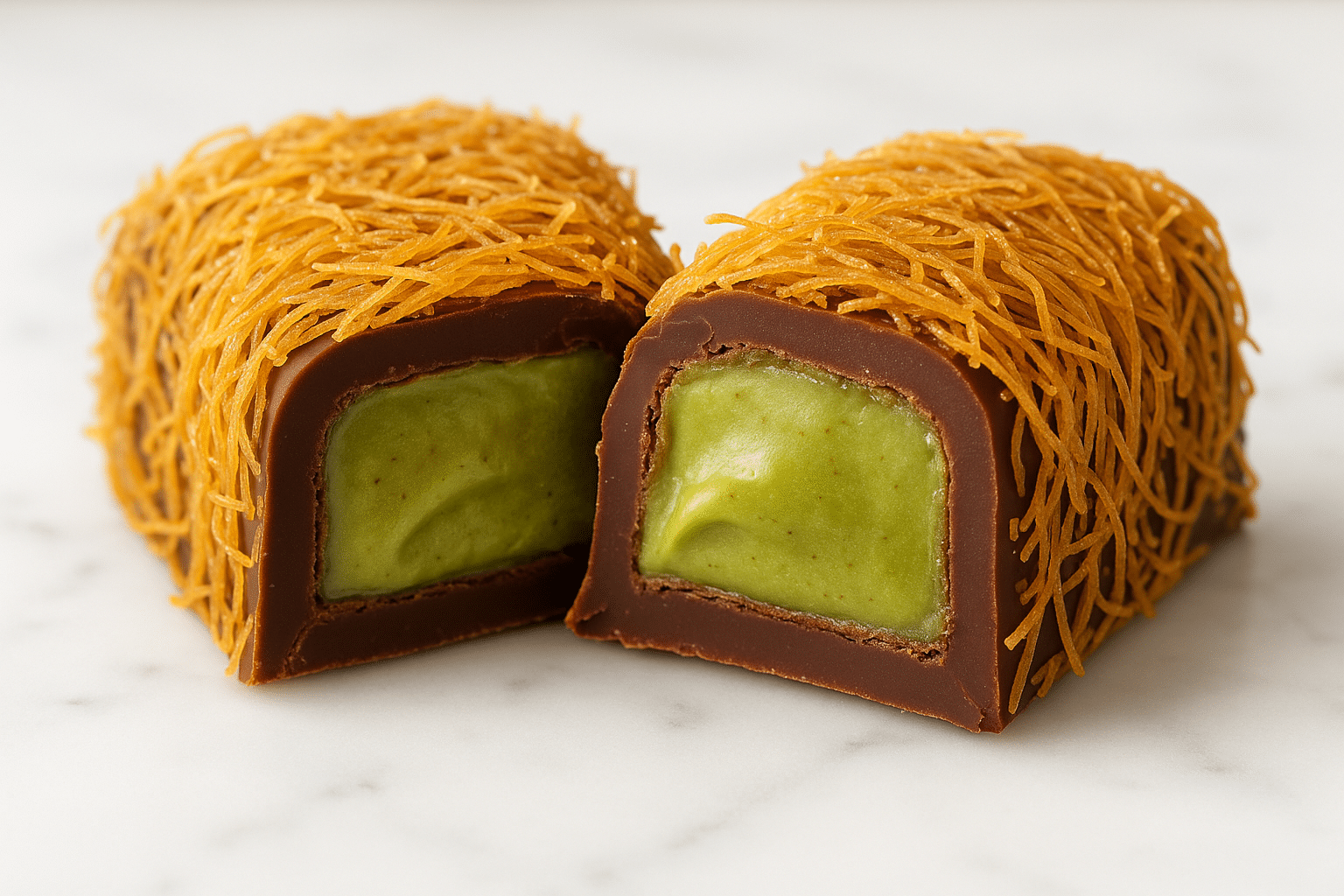The pistachio kataifi chocolate bar has taken social media by storm, becoming the ultimate luxury confection that everyone’s talking about. This extraordinary treat combines the rich decadence of premium chocolate with the unique crunch of kataifi phyllo pastry, creating an absolutely irresistible texture and flavor combination. Originally popularized in Dubai’s high-end confectioneries, these viral chocolate bars have captured hearts worldwide with their stunning visual appeal and complex taste profile.
What makes these bars truly special isn’t just their Instagram-worthy appearance, but the masterful balance of creamy pistachio filling and delicate, crispy kataifi threads that create an unexpected textural symphony. Whether you’re searching for “pistachio kataifi chocolate bar near me” or wondering what makes the Dubai pistachio kataifi chocolate bar so incredibly expensive, this comprehensive guide will walk you through everything you need to know about creating your own version at home.
Understanding the Pistachio Kataifi Chocolate Bar Phenomenon
The Origins and Rise of the Dubai Pistachio Chocolate Bar
The pistachio kataifi chocolate bar phenomenon began in Dubai’s luxury confectionery scene, where innovative chocolatiers started experimenting with traditional Middle Eastern ingredients. These artisans discovered that combining premium chocolate with kataifi pastry creates an extraordinary sensory experience that perfectly captures the essence of Middle Eastern hospitality and luxury.
The viral nature of these chocolate bars can be attributed to their visual appeal and unique texture. When you bite into a pistachio kataifi chocolate bar, the delicate kataifi threads provide an unexpected crunch that contrasts beautifully with the smooth chocolate shell and creamy pistachio filling. This textural complexity, combined with the rich, nutty flavor of premium pistachios, creates a memorable eating experience that people can’t help but share on social media.
Dubai’s reputation for luxury and innovation made it the perfect launching pad for this confection. High-end hotels and specialty chocolate shops began featuring these bars as signature items, often priced at premium levels due to the quality of ingredients and intricate preparation methods. The whipped pistachio cream eclairs we feature on our site showcase similar flavor profiles that make pistachio-based desserts so universally appealing.
Social media influencers and food bloggers quickly caught on to the trend, sharing videos of the satisfying crunch and beautiful cross-sections of these bars. The hashtag #pistachiokatailichocolatebar started trending across platforms, with food enthusiasts from around the world seeking to recreate or purchase these luxurious treats.
What Makes the Kataifi Chocolate Bar So Special
The magic of the pistachio kataifi chocolate bar lies in its sophisticated combination of textures and flavors. Kataifi, also known as shredded phyllo pastry, provides a unique textural element that sets these bars apart from traditional chocolate confections. When properly prepared, the kataifi maintains its delicate crispness while absorbing the flavors of the pistachio cream, creating layers of taste and texture in every bite.
The pistachio cream and kataifi filled dark chocolate bar represents a perfect marriage of Middle Eastern confectionery traditions with modern chocolate-making techniques. The process involves carefully toasting the kataifi to achieve the perfect golden color and crunch, then combining it with rich pistachio paste or cream to create a filling that’s both luxurious and texturally interesting.
Quality plays a crucial role in the success of these bars. Premium chocolate, whether dark, milk, or white, provides the foundation, while high-quality pistachios ensure the characteristic nutty flavor that makes these bars so addictive. The kataifi must be fresh and properly handled to maintain its delicate structure throughout the chocolate-making process.
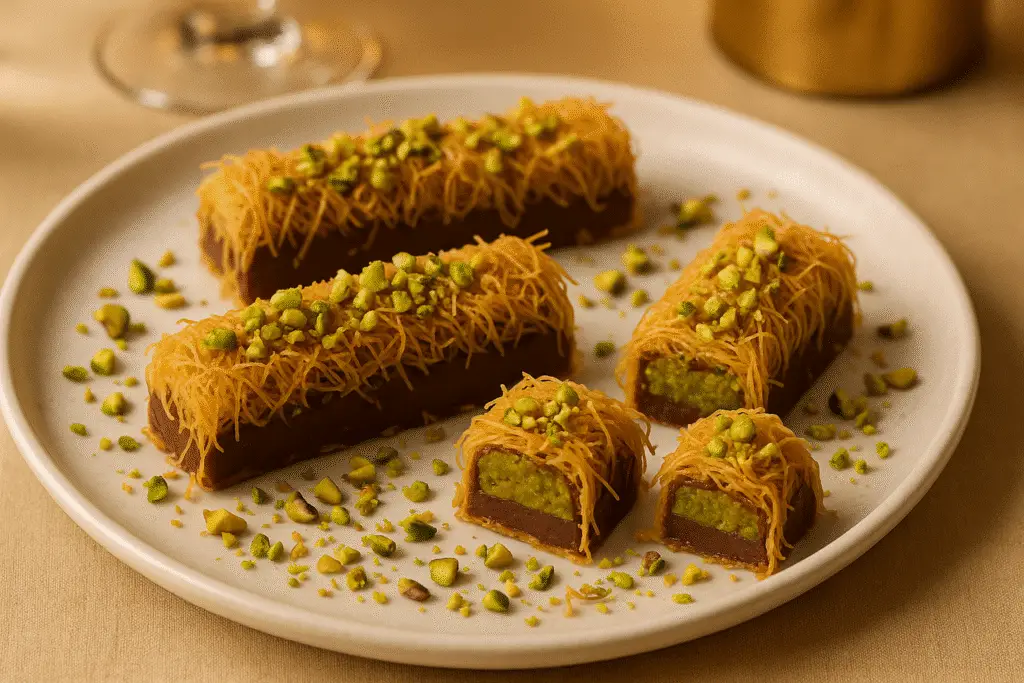
Temperature control is also essential when creating the perfect pistachio kataifi chocolate bar recipe. The chocolate must be properly tempered to achieve a glossy finish and satisfying snap, while the pistachio-kataifi filling needs to be at the right consistency to hold together without becoming too dense or heavy. This attention to detail explains why authentic versions command such high prices in specialty shops.
| Component | Function | Quality Indicators |
|---|---|---|
| Premium Chocolate | Outer shell and base flavor | Glossy finish, clean snap, smooth melt |
| Pistachio Paste | Rich nutty flavor profile | Vibrant green color, smooth texture, intense flavor |
| Kataifi Pastry | Textural contrast and crunch | Golden color, delicate threads, crisp texture |
Mastering the Perfect Kataifi Pistachio Chocolate Bar Recipe
Essential Ingredients and Quality Considerations
Creating an authentic dubai kataifi pistachio chocolate bar requires careful attention to ingredient quality and sourcing. The foundation starts with premium chocolate – whether you choose dark chocolate for its sophisticated bitterness that complements the pistachios, or milk chocolate for a sweeter, more approachable flavor profile. Many chocolatiers prefer using chocolate with 60-70% cocoa content for the perfect balance.
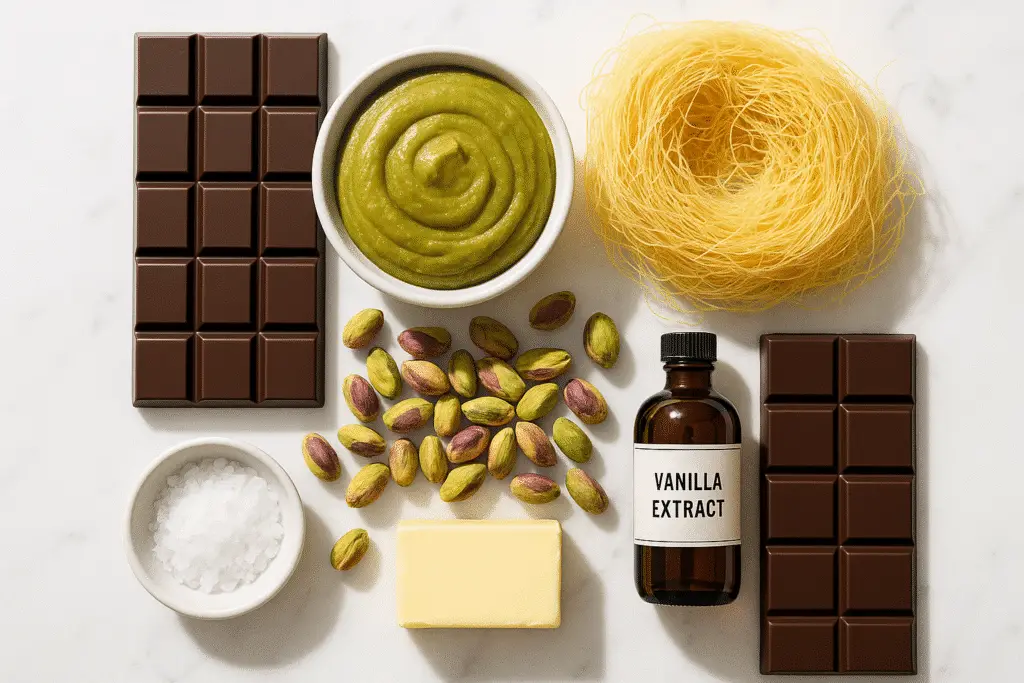
The pistachio component is arguably the most critical element of your kataifi pistachio chocolate bar recipe. Sicilian or Turkish pistachios are preferred for their superior flavor and vibrant green color. These pistachios should be fresh, properly stored, and free from any rancid notes. You’ll need both whole pistachios for texture and pistachio paste or butter for the creamy base. If pistachio paste isn’t available, you can create your own by processing high-quality shelled pistachios until they form a smooth, creamy consistency.
Kataifi pastry, the star textural component, can be found in Middle Eastern grocery stores or specialty food suppliers. This delicate shredded phyllo pastry should be handled carefully and kept covered to prevent drying out. Fresh kataifi has a slightly flexible texture and should pull apart easily into individual strands. If you’re wondering about alternatives for “dubai pistachio chocolate bar what if no kataifi,” you could substitute with finely chopped toasted phyllo pastry or even crushed baklava, though the texture won’t be quite the same.
Additional ingredients include high-quality butter for binding, a touch of vanilla extract to enhance the overall flavor profile, and optionally, a pinch of sea salt to balance the sweetness. Some recipes incorporate a small amount of honey or sugar to adjust the sweetness level of the pistachio filling. The melty pistachio cream dishes we’ve featured demonstrate how versatile pistachio preparations can be in various culinary applications.
Step-by-Step Preparation Techniques
The preparation of your pistachio kataifi chocolate bar begins with properly handling and preparing the kataifi pastry. Start by carefully separating the delicate strands, removing any large clumps while maintaining the thread-like structure that gives these bars their characteristic appearance. Lightly toast the kataifi in a dry pan over medium-low heat, stirring constantly until it achieves a beautiful golden color and develops a nutty aroma.
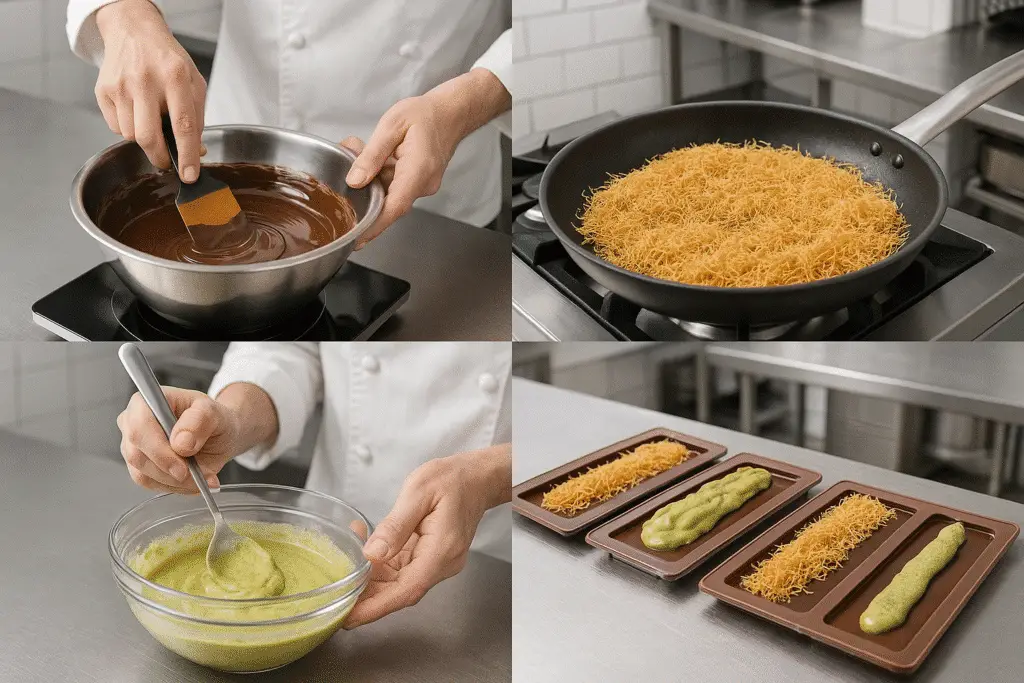
Next, prepare your pistachio filling by combining pistachio paste with softened butter, creating a smooth, spreadable consistency. The mixture should hold together without being too stiff or too loose. Add a touch of vanilla and a pinch of salt to enhance the flavors. Gradually fold in the toasted kataifi, ensuring even distribution while being gentle enough to maintain the delicate structure of the pastry threads.
Chocolate tempering is crucial for achieving professional results in your dubai pistachio kataifi chocolate bar. Melt your chocolate slowly using the double boiler method, bringing it to approximately 115°F (46°C) for dark chocolate. Then cool it to 84°F (29°C) while stirring continuously, before gently reheating to 88°F (31°C). This tempering process ensures your finished bars will have a glossy appearance and satisfying snap.
Assembly requires patience and precision. Line your chocolate molds with tempered chocolate, creating an even shell. Allow this to set partially before adding your pistachio-kataifi filling, leaving enough space for the final chocolate layer. The filling should be evenly distributed and level for the best appearance. Finally, seal with another layer of tempered chocolate, ensuring all edges are properly covered. Similar attention to detail is required in our honey pistachio cream creations, where texture and presentation are equally important.
| Preparation Stage | Key Temperature | Timing | Critical Points |
|---|---|---|---|
| Kataifi Toasting | Medium-low heat | 3-5 minutes | Constant stirring, golden color |
| Chocolate Tempering | 88°F (31°C) final | 15-20 minutes | Proper crystal formation |
| Final Setting | Room temperature | 2-4 hours | Complete crystallization |
The Economics and Appeal Behind Expensive Pistachio Bars
Understanding the Premium Pricing Structure
The question “why is the pistachio chocolate bar so expensive?” has multiple layers of answers that extend beyond simple ingredient costs. Premium pistachios, particularly those from Sicily or specific regions of Turkey and Iran, command high prices due to their superior quality, limited growing regions, and labor-intensive harvesting processes. These pistachios can cost 10-15 times more than conventional varieties, immediately impacting the base cost of any pistachio kataifi chocolate bar.
The artisanal nature of crafting these bars also contributes significantly to their cost. Each bar requires individual attention, from the careful preparation of kataifi pastry to the precise tempering of chocolate and hand-assembly of components. Professional chocolatiers often spend years perfecting their technique, and this expertise comes at a premium. The time investment alone – from preparation to final setting – can span several hours for a single batch.
Additionally, the specialized equipment required for proper chocolate work, including tempering machines, precision molds, and climate-controlled environments, represents substantial overhead costs that must be factored into pricing. Many artisanal producers also use single-origin chocolates or custom blends, further increasing the base material costs. The premium chocolate desserts we create demonstrate how quality ingredients directly impact both taste and cost.
Marketing and positioning also play crucial roles in the pricing of dubai pistachio kataifi chocolate bars. These treats have been positioned as luxury items, often sold in high-end establishments or specialty boutiques where the entire shopping experience contributes to the perceived value. The Instagram-worthy presentation, elegant packaging, and exclusivity factor all justify premium pricing in consumers’ minds.
Market Demand and Social Media Influence
The viral nature of pistachio kataifi chocolate bars has created unprecedented demand that far exceeds supply in many markets. This imbalance naturally drives prices higher, as consumers are willing to pay premium amounts for trending food experiences. Social media platforms, particularly TikTok and Instagram, have amplified this demand by showcasing the satisfying crunch and beautiful cross-sections of these bars.
The “pistachio kataifi chocolate bar near me” search trend reflects the geographic limitations of availability. Many artisanal producers operate on small scales, unable to meet widespread demand, which creates scarcity value. This scarcity, combined with the photogenic nature of the product, has turned these chocolate bars into status symbols and must-try experiences for food enthusiasts.
Influencer marketing has also played a significant role in elevating the perceived value of these bars. Food bloggers and social media personalities regularly feature these treats, often emphasizing their luxury nature and unique characteristics. This constant exposure keeps the bars in the public consciousness while reinforcing their premium positioning.
The seasonality of pistachios and kataifi pastry availability can also impact pricing throughout the year. Peak harvest seasons may offer slight cost reductions, while off-season periods see increased prices due to storage and import costs. Understanding these market dynamics helps explain why some producers charge significantly more during certain periods. Our alternative chocolate desserts offer accessible luxury for those seeking similar indulgent experiences at different price points.
| Cost Factor | Impact Level | Percentage of Total Cost |
|---|---|---|
| Premium Pistachios | High | 25-35% |
| Artisanal Labor | High | 30-40% |
| Premium Chocolate | Medium | 15-20% |
| Packaging & Marketing | Medium | 10-15% |
Creating Your Own Pistachio Kataifi Chocolate Bar Experience
Home Kitchen Techniques and Equipment
Creating professional-quality pistachio kataifi chocolate bars at home requires some specialized techniques, but it’s entirely achievable with the right approach and equipment. Start by investing in a good digital thermometer for chocolate tempering – this is non-negotiable for achieving the glossy finish and proper snap that characterizes high-quality chocolate work. A double boiler setup or dedicated chocolate melter will provide the gentle, controlled heat necessary for proper tempering.
For molds, silicone chocolate bar molds work excellently for home production, offering easy release and consistent sizing. If you can’t find specific chocolate bar molds, ice cube trays or small loaf pans can serve as alternatives, though the final appearance may be less refined. The key is ensuring your molds are completely clean and dry before use, as any moisture or residue will affect the chocolate’s appearance and texture.
When working with kataifi pastry at home, proper storage is crucial. Keep it covered with a damp towel when not in use to prevent drying out, but ensure the towel doesn’t directly touch the pastry. A large, shallow pan works best for toasting the kataifi, allowing you to spread it in a single layer for even browning. The toasting process should be done slowly and with constant stirring to achieve uniform color and crispness.
Temperature control throughout your kitchen workspace is important for chocolate work. Ideally, your kitchen should be around 65-70°F (18-21°C) with low humidity. If your kitchen is too warm, consider working in air conditioning or during cooler parts of the day. The chocolate-based desserts we feature demonstrate similar temperature considerations for achieving professional results at home.
Troubleshooting and Perfecting Your Recipe
Common issues when making pistachio kataifi chocolate bars include chocolate bloom, filling separation, and kataifi becoming soggy. Chocolate bloom typically results from improper tempering or temperature fluctuations during setting. To prevent this, ensure your chocolate reaches the correct temperatures during tempering and maintain consistent room temperature while the bars set.
If your pistachio filling separates or becomes too oily, it’s usually due to temperature differences between components or overworking the mixture. Ensure all ingredients are at similar temperatures before combining, and fold rather than mix aggressively when incorporating the kataifi. If separation occurs, try gradually warming the mixture while stirring gently to re-emulsify.
Soggy kataifi is perhaps the most frustrating issue, as it defeats the purpose of including this textural element. This problem typically stems from insufficient toasting, exposure to moisture, or combining the kataifi with warm filling. Always toast the kataifi until completely crisp and golden, allow it to cool completely before use, and ensure your pistachio mixture isn’t too warm when folding in the pastry.
For storage and longevity, properly made pistachio kataifi chocolate bars can last up to two weeks when stored in a cool, dry place. Wrap individual bars in parchment paper or store in airtight containers with parchment between layers. Avoid refrigeration, as this can cause chocolate bloom and may soften the kataifi. The texture and flavor actually improve slightly after 24-48 hours as the components meld together. Similar storage principles apply to our quick fudge recipes, where proper storage maintains texture and quality.
| Common Problem | Likely Cause | Solution |
|---|---|---|
| Chocolate Bloom | Improper tempering | Follow tempering temperatures precisely |
| Soggy Kataifi | Insufficient toasting or moisture | Toast until golden, cool completely |
| Filling Separation | Temperature differences | Match component temperatures |
Frequently Asked Questions
Why is the pistachio chocolate bar so expensive?
The pistachio chocolate bar commands premium pricing due to several factors. High-quality pistachios, especially those from Sicily or Turkey, are inherently expensive due to limited growing regions and labor-intensive harvesting. Additionally, the artisanal production process requires skilled chocolatiers, specialized equipment, and significant time investment. Premium chocolate, precise tempering techniques, and elegant packaging all contribute to the final cost, making these bars a luxury confection rather than everyday candy.
What is kataifi chocolate bar?
A kataifi chocolate bar is a premium confection that incorporates kataifi pastry – thin, shredded phyllo dough – into the chocolate filling. The kataifi provides a unique textural contrast with its delicate, crispy strands that create an unexpected crunch within the smooth chocolate. When combined with pistachio cream or paste, the kataifi adds both texture and subtle nutty flavor, creating a multi-layered eating experience that sets these bars apart from traditional chocolate confections.
What is the crunchy stuff in the pistachio chocolate bar?
The distinctive crunch in pistachio chocolate bars comes from kataifi pastry, which consists of extremely thin strands of phyllo dough. This pastry is carefully toasted until golden and crispy before being incorporated into the pistachio filling. The kataifi maintains its delicate, thread-like structure while absorbing the flavors of the pistachio cream, creating a satisfying textural contrast that makes each bite interesting and memorable.
What does kataifi chocolate taste like?
Kataifi chocolate offers a complex flavor profile that combines rich, smooth chocolate with the nutty sweetness of pistachios and the subtle, toasted notes of the kataifi pastry. The texture is equally important to the experience – you’ll notice the initial snap of quality chocolate, followed by the creamy pistachio filling, and finally the delicate crunch of the kataifi threads. The overall taste is luxurious and sophisticated, with each component complementing the others to create a harmonious and memorable confection.
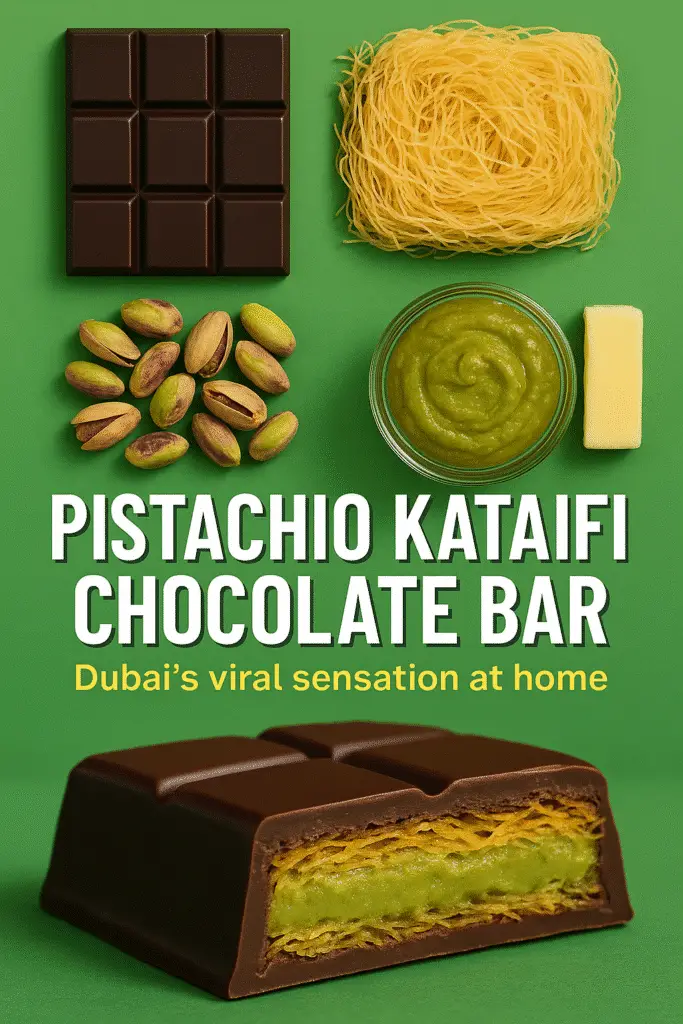
Conclusion
The pistachio kataifi chocolate bar represents more than just a trendy confection – it’s a perfect example of how traditional ingredients can be reimagined to create something entirely new and extraordinary. Whether you’re investing in the authentic Dubai experience or creating your own version at home, these bars offer a unique combination of luxury, flavor, and texture that explains their viral popularity and premium pricing.
By understanding the components, techniques, and market factors behind these remarkable treats, you can appreciate both their complexity and their appeal. The combination of premium pistachios, delicate kataifi pastry, and expertly tempered chocolate creates an experience that transcends ordinary chocolate consumption, making each bite a celebration of craftsmanship and flavor innovation.
We’d love to see your homemade pistachio kataifi chocolate bars! Share your results and connect with our community of food enthusiasts who are passionate about recreating viral food trends at home.
Follow us on social media for more exclusive recipes and cooking tips:
Join thousands of home cooks on our CrennRecipes Facebook page where we share daily recipe inspiration, cooking tips, and behind-the-scenes content from our test kitchen.
Save this recipe and discover hundreds more on our CrennRecipes Pinterest boards. We organize recipes by cuisine, dietary needs, and trending food topics to make meal planning easier.
Join our active CrennRecipes Facebook Group where home cooks share their successes, ask questions, and get personalized cooking advice from fellow food enthusiasts and our culinary team.
Don’t forget to tag us @CrennRecipes when you post your pistachio kataifi chocolate bar creations – we feature our favorite reader recreations on our social channels!
Print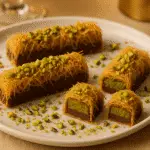
Pistachio Kataifi Chocolate Bar: The Ultimate Guide to Dubai’s Viral Sensation
- Total Time: 4 hours
- Yield: 8 bars 1x
- Diet: Vegetarian
Description
Create the viral Dubai pistachio kataifi chocolate bar at home with this authentic recipe featuring crispy phyllo pastry, premium pistachio cream, and perfectly tempered chocolate. This luxurious treat combines rich Middle Eastern flavors with modern chocolate-making techniques.
Ingredients
200g high-quality dark chocolate (60-70% cocoa)
100g kataifi pastry (shredded phyllo dough)
80g premium pistachio paste
30g unsalted butter, softened
1/2 teaspoon vanilla extract
Pinch of sea salt
2 tablespoons chopped pistachios (optional, for extra texture)
Additional chocolate for tempering (if needed)
Instructions
1. Carefully separate the kataifi pastry strands, removing any large clumps while maintaining the delicate thread-like structure.
2. Toast the kataifi in a dry pan over medium-low heat, stirring constantly until golden and crispy, about 3-5 minutes. Set aside to cool completely.
3. In a mixing bowl, combine the pistachio paste, softened butter, vanilla extract, and sea salt. Mix until smooth and well combined.
4. Gently fold the cooled toasted kataifi into the pistachio mixture, being careful not to break the delicate strands.
5. Temper the chocolate using the double boiler method: melt to 115°F (46°C), cool to 84°F (29°C), then reheat to 88°F (31°C).
6. Line chocolate bar molds with the tempered chocolate, creating even shells. Tap to remove air bubbles and allow to set partially.
7. Fill the chocolate shells with the pistachio-kataifi mixture, leaving space for the final chocolate layer.
8. Seal the bars with the remaining tempered chocolate, ensuring all edges are properly covered.
9. Allow the bars to set completely at room temperature for 2-4 hours.
10. Carefully remove from molds and store in a cool, dry place.
Notes
Use a digital thermometer for accurate chocolate tempering – this is crucial for professional results.
Ensure the kataifi is completely cool before mixing with the pistachio paste to prevent melting.
Work in a cool kitchen environment (65-70°F/18-21°C) for best chocolate work conditions.
The bars actually improve in flavor after 24-48 hours as the components meld together.
Store in airtight containers at room temperature for up to 2 weeks. Do not refrigerate as this can cause chocolate bloom.
If kataifi pastry is unavailable, substitute with finely chopped toasted phyllo pastry or crushed baklava.
- Prep Time: 45 minutes
- Cook Time: 5 minutes
- Category: Dessert
- Method: No-Bake
- Cuisine: Middle Eastern
Nutrition
- Serving Size: 1 bar (approximately 45g)
- Calories: 285
- Sugar: 18g
- Sodium: 25mg
- Fat: 20g
- Saturated Fat: 12g
- Unsaturated Fat: 8g
- Trans Fat: 0g
- Carbohydrates: 22g
- Fiber: 3g
- Protein: 6g
- Cholesterol: 8mg

